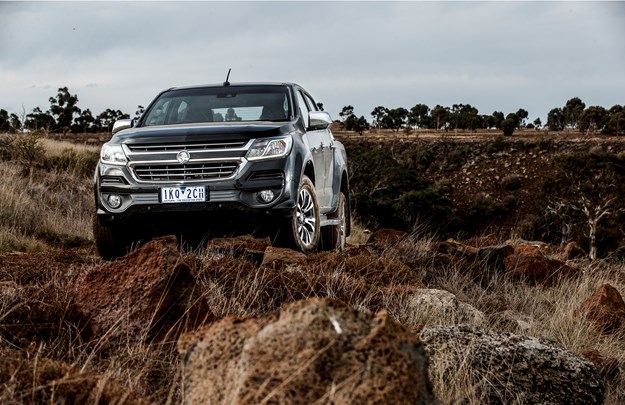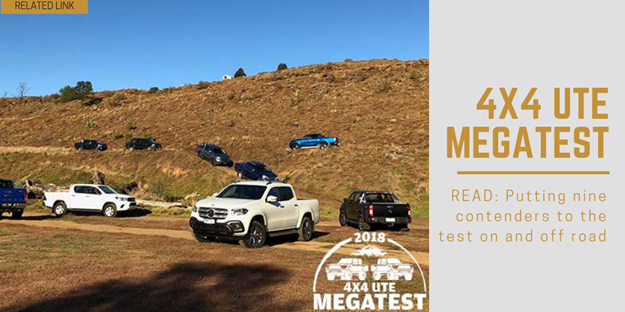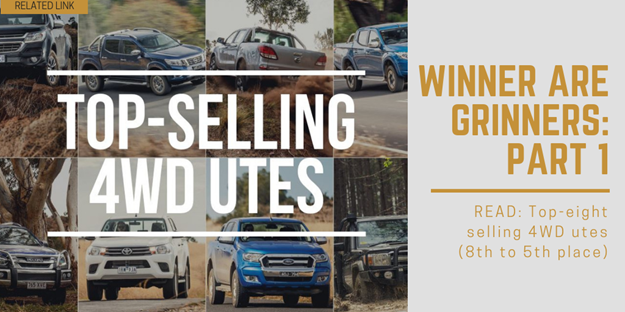Australians love utes – especially 4WD utes – like never before. Here’s a rundown on the eight best-selling 4WD utes for the first six months of the year
Year-on-year sales of new 4WD utes continues to boom thanks largely to some 5,900 new units being sold in the first half of 2018 compared with the first six months of 2017. That represents a healthy 7.1 per cent increase.
Toyota’s Hilux has squeezed back past Ford’s Ranger into the number-one spot not just in the 4WD ute market but also in the overall 4WD market where dual cabs now outsell the most popular of the 4WD wagons, the Toyota Prado. Some 80 to 90 per cent of utes sold are dual cabs, which reflects the repositioning of utes away from being purely work vehicles.
Against this background of stronger sales not all of the most popular utes are selling better than they did this time last year…
4: Holden Colorado
The Colorado was the big mover in 4WD ute sales this time last year but has hit a snag
The Colorado is the highest ranked of the best-selling 4WD utes that has gone backwards in sales in the first six months of 2018 compared with the same time last year. The slower 2018 sales come off the back of a big surge in 2017 with a year-on-year 11.2 per cent slide reversing most of the 2017 gains.
This generation Colorado first appeared in 2012, was tweaked just 12 months later and then again the year after before being pulled it completely apart and put it back together again for the 2017 model year. What resulted was a completely different vehicle from what had gone before.
The changes to the engine, transmission, chassis and body were deep, extensive and thorough, resulting in a vehicle that’s far smoother and quieter engine-wise, rides and handles better on road and is far more capable off-road.
The Colorado’s strong points include its punchy 2.8-litre engine that lives up to the promise of its 500Nm, a figure that betters the 470Nm of the notably bigger engine in the Ranger. The Colorado’s engine is revvy and willing and is aided by what is the best of the automatic gearboxes in any ute bar Volkswagen’s Amarok.
The Colorado is also now a polished on-road drive in terms of its steering and suspension performance and if you want it to carry or tow anything notably heavy, it will do that too without complaint.
Best of all, the Colorado is now a much better off road now thanks to its electronic traction control that’s been specifically tweaked to improve its off-road effectiveness. It’s still no Hilux, Ranger or Amarok off-road, but it’s far better than what it was.
Sales
2018 sales (to June 30th): 8,526
2017 sales (to June 30th): 9,603
Change: Down 11.2%
Report Card
Engine and gearbox: B
Handing and ride: B
Cabin and equipment: C
Load and tow: B
Off-road: C
Comment: The Colorado is finally the ute it should have been right from the start.
Specs: Holden Colorado LTZ Crew Cab
Engine: 2.8-litre 4-cyl turbo diesel
Max Power/Torque: 147kW (197hp)/500Nm
Gearbox: Six-speed automatic
4X4 System: Dual-range part-time
Kerb Weight: 2,121kg
GVM: 3,150kg
Towing capacity: 3,500kg
GCM: 6,000kg
Fuel tank capacity: 76 litres
ADR fuel claim: 8.7 litres/100km
READ: Holden Colorado – 2018 4×4 Ute Megatest
3: Mitsubishi Triton
Unbeatable on value, the Triton delivers more than it promises

Mitsubishi’s Triton is the big mover at the pointy end of the 4WD ute sales chart despite remaining in third place overall and still a long way behind the two runaway leaders in Hilux and Ranger.
Still, Triton sales are up nearly 20 per cent without Mitsubishi doing much more than a mild tweak of the model line-up, which among other changes has seen the introduction of the Blackline dual cab.
The Triton sales success has much to do with its sharp pricing and Mitsubishi’s ongoing factory discounting with driveaway prices on the popular dual-cab variants sitting well below the other mainstream utes and bettered only by the Indian and Chinese offerings. Dual cabs make up 11,570 of the 12,127 Triton 4WDs sold (so over 95 per cent) while automatics make up 73 per cent of all 4WD sales.
The Triton stands out amongst the current crop of 4WD utes in a number of ways. One is the full-time 4WD system of GLS and Exceed models thanks to Mitsubishi’s ‘Super Select’ system. Most utes have less sophisticated part-time 4WD.
Full-time 4WD adds greatly to the Triton’s functionality, driveability and safety under most driving conditions and stands the Triton apart from all its competitors bar the Amarok. Super Select also has a 2WD mode, so it’s different again from a conventional full-time system.
Unfortunately, Super Select doesn’t make the Triton a gun off-road ute but that’s all to do with its modest suspension travel and ground clearance and nothing to do with the Super Select system.
The Triton is also a small ute by class standards in cabin size, payloads and towing capacity. The fact that most of the tray of the dual-cab models overhangs the rear axle is also a negative when it comes to carrying or towing heavy loads, although the 2.4-litre diesel holds up its end even if the chassis layout isn’t ideal.
One positive here is that the Triton is more manoeuvrable than the others in its class thanks to its relatively short wheelbase, and also has sporty feel to the way it steers and handles thanks in part to also being lighter than most competitors.
Sales
2018 sales (to June 30th): 12,187
2017 sales (to June 30th): 10,318
Change: Up 18.1%
Report Card
Engine and gearbox: C
Handling and ride: B
Cabin and equipment: C
Load and tow: D
Off-road: D
Comment: Strong on value, but not as big or as capable off road or as good as a work ute as others.
Specs: Mitsubishi Triton GLS
Engine: 2.4-litre 4-cyl turbo diesel
Max Power/Torque: 133kW (178hp)/430Nm
Gearbox: Five-speed automatic
4X4 System: Dual-range full-time (+2WD)
Kerb Weight: 1,950kg
GVM: 2,900kg
Towing capacity: 3,100kg
GCM: 5,885kg
Fuel tank capacity: 75 litres
ADR fuel claim: 7.6 litres/100km
READ: Mitsubishi Triton – 2018 4×4 Ute Megatest
2: Ford Ranger
After knocking off the Hilux last year, the Ranger has been pipped at the post at the halfway point in 2018
Some 19,216 Ranger 4WDs have been sold in the first six months of 2018, a 3.5 per cent increase over the same period in 2017. Unfortunately for Ford, that number puts Ranger just 21 units short of Hilux and for the time being has silenced Ranger’s claim of being Australia’s top-selling 4WD ute.
But that could soon change with the imminent arrival of a new engine in the Ranger. It’s a more powerful (157kW/500Nm) but very much smaller two-litre four-cylinder option to the current 147kW (197hp)/470Nm 3.2-litre five-cylinder diesel in best-selling XLT and Wildtrak models.
The new Ranger will also bring a host of other suspension, NVH and equipment upgrades. The new bi-turbo engine, which brings a surprisingly modest premium of just $1,200 over the 3.2 will only be available with a 10-speed automatic.
There’s also a new ‘hero’ model to help bolster the line-up in the form of the Ranger Raptor, which will also be powered by the new engine and comes with a bespoke high-performance suspension.
How this relatively small-capacity engine will be accepted in a ute whose popularity has been in some part based on its biggest-in-class engine is yet to be seen and is no doubt the reason why Ford will keep the 3.2 in the range to cover its bets. The two-litre won’t be offered with a manual, which is another reason why the 3.2 will be kept as cover, at least for the time being.
The Ranger has built its success on a big and spacious cabin, excellent on-road driving dynamics and class-leading towing and load-carrying ability. Interestingly, the Ranger’s 3,500kg maximum tow capacity is undiminished with the two-litre engine, except with the Raptor where it drops to 2,500kg.
Hopefully the new engine won’t affect the Ranger’s off-road ability, which is currently as good as it gets in its class. One promise the new two-litre engine brings is, however, better fuel economy, always a notable negative with the 3.2.
Sales
2018 sales (to June 30th): 19,216
2017 sales (to June 30th): 18,563
Change: Up 3.5%
Report Card
Engine and gearbox: B
Handling and ride: B
Cabin and equipment: B
Load and tow: A
Off-road: A
Comment: Continues to impress with top-shelf off-road, load and tow performance mated to an enjoyable everyday driving experience.
Specs: Ford Ranger XLT Double Cab
Engine: 3.2-litre 5-cyl turbo diesel
Max power/torque: 147kW (197hp)/470Nm
Gearbox: Six-speed automatic
4X4 System: Dual-range part-time
Kerb Weight: 2,159kg
GVM: 3,200kg
Towing capacity: 3,500kg
GCM: 6,000kg
Fuel tank capacity: 80 litres
ADR fuel claim: 9.2 litres/100km
READ: Ford Ranger – 2018 4×4 Ute Megatest
1: Toyota Hilux
The Hilux is back as Australia most popular 4WD after its 12-year run at the top 4WD sales charts was broken last year by the Ford Ranger
The Hilux is so popular it’s not just the best-selling 4WD, ute or otherwise, it’s Australia’s best-selling new ‘car’ overall, the only ute to achieve that distinction. Up to mid-year’s end Hilux 4WD models alone outsold Australia’s most passenger car the Toyota Corolla. For every three Hilux 4WDs it sells, Toyota also sells one Hilux 2WD, which puts the Hilux even further out front in the overall sales race.
Last year, however, the Hilux was deposed as Australia’s best-selling 4WD ute by the Ford Ranger. Toyota responded by fleshing out the Hilux model range by fitting alloys and sat-nav to the work-spec SR to create the SR+, and adding heated seats to the SR5+ to match top-spec rivals. Then came a range of accessorised models, first the TRD and then more recently the Rogue, Rugged and Rugged X.
Compared with the first six months of 2017 Hilux 4WD sales are up 12.2 per cent, sufficient to see it squeeze back in front of Ranger by a mere 21 units, despite Hilux buyers no longer having the option of the petrol V6. Dual-cabs make up 86 per cent of Hilux 4WD sales with single and extended cabs evenly split in the remaining 14 per cent.
Somewhat controversially, Toyota decided to downsize from a three-litre diesel four to a 2.8-litre four in this latest-generation Hilux, which puts it at a disadvantage against the notably bigger 3.2-litre five-cylinder engine in the Ranger in a market where big engines are seen to not have to work as hard as smaller engines to do the same job.
While the 2.8 is well short of the Ranger in performance, let alone the Amarok V6, it is a quiet, refined and nicely flexible engine. Three-quarters of all Hilux 4WD buyers opt for the six-speed automatic despite its tendency to shuffle between fifth and sixth gears at legal highway speeds on undulating roads, which makes the manual the better choice for country driving.
There’s no doubting the Hilux off-road ability however, which is as good as it gets in its class. Build quality, day-to-day ownership practicality and after-market support are also second to none but Hilux loses to most rivals in cabin size and maximum tow and load capability.
Sales
2018 sales (to June 30th): 19,237
2017 sales (to June 30th): 17,140
Change: Up 12.2%
Report Card
Engine and gearbox: C
Handing and ride: C
Cabin and equipment: C
Load and tow: C
Off-road: A
Comment: Back on top but needs more to keep it competitive.
Specs: Toyota Hilux SR5 Double-Cab
Engine: 2.8-litre 4-cyl turbo diesel
Max Power/Torque: 130kW (174hp)/450Nm
Gearbox: Six-speed automatic
4X4 System: Dual-range part-time
Kerb Weight: 2,075kg
Towing capacity: 3,200kg
GCM: 5,650kg
Fuel tank capacity: 80 litres
ADR fuel claim: 8.5 litres/100km
READ: Toyota Hilux – 2018 4×4 Ute Megatest







